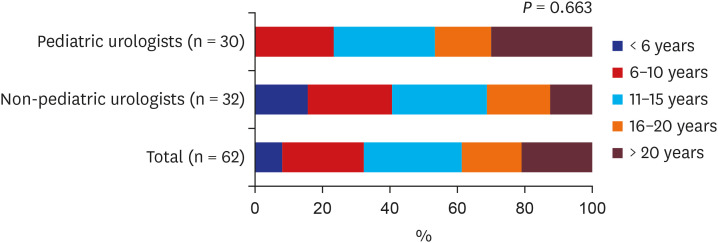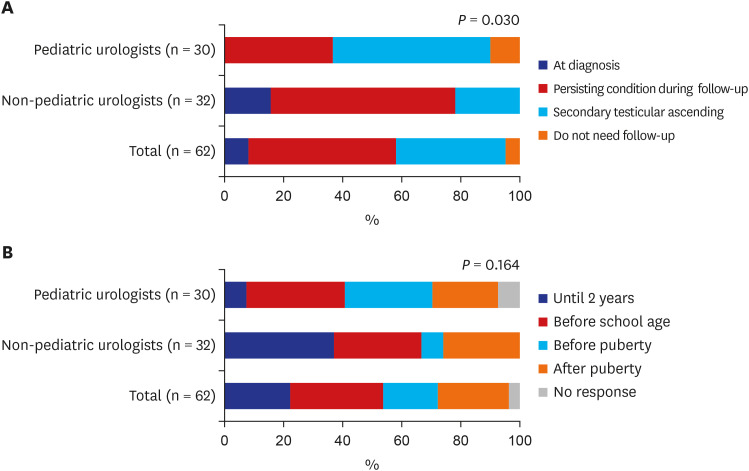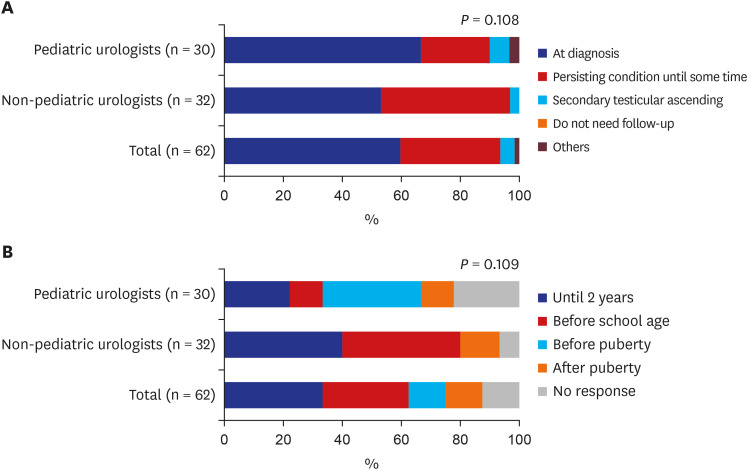J Korean Med Sci.
2022 Mar;37(12):e98. 10.3346/jkms.2022.37.e98.
Comprehension and Practice Patterns of Korean Urologists for Retractile and Gliding Testes
- Affiliations
-
- 1Department of Urology, Pusan National University Yangsan Hospital, Yangsan, Korea
- 2Department of Urology, Pusan National University School of Medicine, Yangsan, Korea
- 3Research Institute for Convergence of Biomedical Science and Technology, Pusan National University Yangsan Hospital, Yangsan, Korea
- KMID: 2527639
- DOI: http://doi.org/10.3346/jkms.2022.37.e98
Abstract
- Background
It is quite difficult to distinguish retractile testis from gliding testis, which requires different treatment planning in the clinic setting. We evaluated practice patterns of urologists in Korea regarding the diagnosis and management of retractile and gliding testes.
Methods
We mailed or e-mailed self-completion questionnaires consisting of 20 items to 106 urologists practicing in Korean hospitals concerning the diagnosis and treatment of cryptorchidism. We collected and analyzed the responses statistically.
Results
Responses were received from 62 urologists. The response rate was 58.5%. Thirtyseven urologists (59.7%) actually felt they had difficulty in distinguishing retractile testis from gliding testis in the clinic setting. This rate was higher for non-pediatric urologists (78.1%) than for pediatric urologists (40.0%) (P = 0.006). In cases of infant retractile testis, only five urologists (8.1%) said that they would perform orchiopexy immediately, with 54 (87.1%) urologists saying they would do follow-up. In cases of preschool-age children with retractile testis, 17 urologists (27.4%) said that they would perform orchiopexy immediately with 41 (66.1%) urologists saying they would do follow-up. In cases of infant gliding testis, 37 urologists (59.7%) said that they would perform orchiopexy immediately with 24 (38.7%) urologists saying they would do a follow-up.
Conclusion
More than half (59.7%) of Korean urologists revealed it challenging to distinguish retractile testis and gliding testis in the clinical setting. The more it was difficult to diagnose retractile testis with certainty, the more frequent surgical correction was chosen for treatment. Therefore, it is essential to prevent unnecessary surgical treatment by establishing a practical guideline.
Keyword
Figure
Reference
-
1. Wohlfahrt-Veje C, Boisen KA, Boas M, Damgaard IN, Kai CM, Schmidt IM, et al. Acquired cryptorchidism is frequent in infancy and childhood. Int J Androl. 2009; 32(4):423–428. PMID: 19515170.2. Sijstermans K, Hack WW, Meijer RW, van der Voort-Doedens LM. The frequency of undescended testis from birth to adulthood: a review. Int J Androl. 2008; 31(1):1–11.3. Hack WW, Sijstermans K, van der Voort-Doedens LM, Meijer RW, Haasnoot K. The high scrotal (“gliding”) testis revised. Eur J Pediatr. 2007; 166(1):57–61. PMID: 16896645.4. Barthold J, Hagerty J. Etiology, diagnosis, and management of the undescended testis. Wein AJ, Kavoussi LR, Partin AW, Peters CA, editors. Campbell-Walsh Urology. 11th ed. Vol. 4. Philadelphia, PA, USA: Elsevier;2015. p. 3430–3452.5. Goede J, van der Voort-Doedens LM, Sijstermans K, Hack WW. The volume of retractile testes. J Urol. 2011; 186(5):2050–2054. PMID: 21944090.6. Keys C, Heloury Y. Retractile testes: a review of the current literature. J Pediatr Urol. 2012; 8(1):2–6. PMID: 21497555.7. La Scala GC, Ein SH. Retractile testes: an outcome analysis on 150 patients. J Pediatr Surg. 2004; 39(7):1014–1017. PMID: 15213889.8. Agarwal PK, Diaz M, Elder JS. Retractile testis--is it really a normal variant? J Urol. 2006; 175(4):1496–1499. PMID: 16516034.9. Bae JJ, Kim BS, Chung SK. Long-term outcomes of retractile testis. Korean J Urol. 2012; 53(9):649–653. PMID: 23061004.10. Van Essen W. The retractile testis. Postgrad Med J. 1966; 42(486):270–272. PMID: 4380054.11. Wyllie GG. The retractile testis. Med J Aust. 1984; 140(7):403–405. PMID: 6142410.12. Ferro F, Lais A, Matarazzo E, Capozza N, Caione P. Retractile testis and gliding testis. Two distinct clinical entities. Minerva Urol Nefrol. 1996; 48(3):145–149. PMID: 8966651.13. Goh DW, Hutson JM. Is the retractile testis a normal, physiological variant or an anomaly that requires active treatment? Pediatr Surg Int. 1992; 7:249–252.14. Wyllie GG. The diagnosis of undescended testes. Med J Aust. 1978; 1(12):639–641. PMID: 28463.15. Park JW, Kim KS. Incidence, risk factors and spontaneous descent of cryptorchidism. Korean J Urol. 2003; 44:1203–1207.16. Walsh TJ, Dall’Era MA, Croughan MS, Carroll PR, Turek PJ. Prepubertal orchiopexy for cryptorchidism may be associated with lower risk of testicular cancer. J Urol. 2007; 178(4 Pt 1):1440–1446. PMID: 17706709.17. Pettersson A, Richiardi L, Nordenskjold A, Kaijser M, Akre O. Age at surgery for undescended testis and risk of testicular cancer. N Engl J Med. 2007; 356(18):1835–1841. PMID: 17476009.18. Bingöl-Koloğlu M, Tanyel FC, Anlar B, Büyükpamukçu N. Cremasteric reflex and retraction of a testis. J Pediatr Surg. 2001; 36(6):863–867. PMID: 11381413.19. Farrington GH. The position and retractibility of the normal testis in childhood with reference to the diagnosis and treatment of cryptorchidism. J Pediatr Surg. 1968; 3(1):53–59.20. Goh DW, Hutson JM. The retractile testis: time for a reappraisal. J Paediatr Child Health. 1993; 29(6):407–408. PMID: 7904474.21. Lee T, Han SW, Lee MJ, Kim JH, Choi SK, Cho NH, et al. Pathological characteristics in retractile testis comparing cryptorchid testis. Korean J Urol. 1999; 40:617–622.22. Caucci M, Barbatelli G, Cinti S. The retractile testis can be a cause of adult infertility. Fertil Steril. 1997; 68(6):1051–1058. PMID: 9418696.
- Full Text Links
- Actions
-
Cited
- CITED
-
- Close
- Share
- Similar articles
-
- Comprehension and Practice Patterns Toward Cryptorchidism in Korean Urologists
- Pathological Characteristics in Retractile Testis comparing Cryptorchid Testis
- Long-Term Outcomes of Retractile Testis
- Diagnosis and Management of Cryptorchidism
- Gross and Microscopic Findings of the Testes Ascended into abdomen During Neonatal and Prepubertal age in Rats







